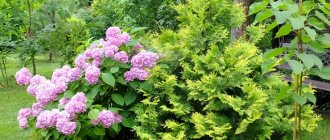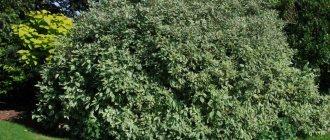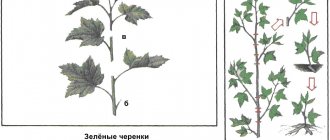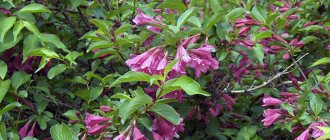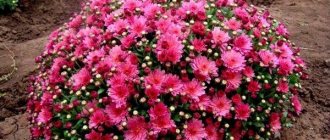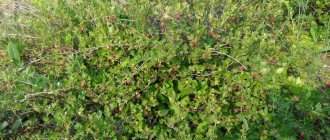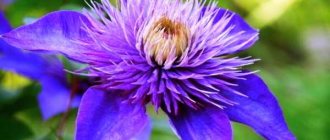Wisteria propagation
If you are lucky and wisteria is already in your hands, then it’s time to consider growing it and further propagating it. In order for new shoots to appear more often and the plant to feel good, you need to:
- plant the plant on the sunny side;
- provide a strong frame or support to allow the wisteria to curl;
- monitor soil moisture, spray in hot weather, reduce watering by autumn;
- add specialized fertilizers;
- take care of reliable shelter for the winter period;
- Prune twice a year to increase flowering stems.
Diseases and pests of wisteria
Wisteria is damaged by aphids and clover mites. When aphids are infested, the leaves become covered with a sticky honey coating and the shoots become bent. A clover mite infestation is indicated by the bronze color of the leaves. For treatment it is necessary to use insecticides, for example Melation. Spraying is carried out in two stages. After the first spraying, repeat spraying is carried out after 8-10 days.
If the plant is planted on calcareous or clay soil, chlorosis may develop. With this disease, the leaves turn pale and yellow, and they may curl. To restore the plant, fertilizing with fertilizer containing iron salts will help.
Growing wisteria from seeds
You need to plant wisteria seeds in winter in a warm room or greenhouse, where the temperature is kept at 22–25 ºС. It is best to do this at the end of November or December.
The soil for planting wisteria seeds should consist of ¼ turf mixed with sand, ¾ leaf soil, with a thin layer of sand sprinkled on top of the mixture.
- Plant the seeds of the plant shallowly.
- Spray with a spray bottle and cover with glass or film to create a greenhouse effect.
- Place in a dark place, wait about a month for sprouts to appear, maintaining soil moisture.
- After sprouting, wait a week and a half and move the pot to the light.
- After forming two leaves on the stem, you need to transplant them into separate pots and water them with a weak solution of potassium permanganate.
The seedlings will experience stress when planted outside; to prevent this from happening, you need to accustom them to the external environment. By spring, the pots should be taken out every day for two hours to where it is cool, the window is open, but there are no drafts.
In the spring, after the last frost has passed, the wisteria is transplanted into open ground. Preparation includes careful digging of the planting site and fertilizing the soil with mineral additives in proportions of 25 g per 1 m2 . In the fertilized area, holes are dug 60x60x50 cm . Shoots should only be planted with soil on the roots, then covered with soil and watered. All you have to do is wait patiently, the young shrub grows for a long time, does not immediately form a trunk, in the first years it grows only with thin vines.
Wisteria from seeds is often grown for a winter garden or bonsai. Seedlings grown at home begin to bloom after 5-7 years.
You can plant flower seeds immediately in open ground, but this should be done closer to summer. Add humus and fertilizer to the planting site; if everything goes well, the plant grown outside will be much more resistant to temperature changes and will easily endure the first wintering.
Location of wisteria on the site
Nowadays it is very fashionable to create various places for relaxation in gardens: gazebos, swings, equipped places for barbecue and barbecue. Wisteria is perfect for decorating such gazebos. The plant does not like windy, shady places. A good planting location could be the sunny side of a gazebo or the wall of a house. Hanging clusters of flowers will decorate arches over garden paths. In this case, there is no need to arrange additional supports, but it is necessary to tie up the vine.
Propagation of wisteria by cuttings
Cuttings are one of the most effective and simplest ways to propagate wisteria.
The method is popular because this is how all the varietal characteristics of the mother plant are preserved. With careful care of the plant, it will not be difficult to achieve active propagation of the plant. To obtain cuttings in early spring, you need to take several last year's shoots and make oblique cuts on them under the buds. The cut site is planted in soil or a flowerpot with a nutrient substrate of turf and clay. During layering, the top of the shoot is tied to a support for strengthening. When summer comes to an end, the cutting will have enough roots to be replanted. At the very beginning of autumn, the cuttings are transplanted to a new place, but you can also wait until next year.
Reproduction will be more effective if you treat the cut sites with a solution of indolylbutyric or indolylacetic acid.
The same can be done in the fall, then a trench is dug up to 20 cm deep , it is fertilized and the cut shoot is bent there. Separation from the mother plant for replanting can be done next fall.
For the winter, young wisteria needs to be wrapped carefully; roofing felt, paper, leaves or special horticultural material for covering will do.
Cuttings
Propagation by cuttings has its own characteristics and can be done in several ways.
First of all, this is the use of lignified cuttings. This method is used to obtain several plant specimens at the same time. It is held in the fall. To prepare cuttings, you can use lignified shoots that were cut off during sanitary pruning of the vine, or they can be prepared specially.
The cuttings that we will root must be at least eight centimeters long with two developed buds.
The next point is the preparation of a wet mixture of earth and sand in a 1:1 ratio. The components are mixed, moistened, then poured into a container. It is into the resulting substrate that the cuttings are laid out. Then the container with the cuttings is placed in a room where the air temperature should be within three to four degrees. The cuttings should remain in this state until spring.
In mid-April they are planted for rooting. For this purpose, planting boxes are prepared with holes for draining excess liquid and a drainage layer. A nutrient substrate is poured into the boxes on top of the drainage, and a centimeter layer of sand is sprinkled on top of the soil. Before planting cuttings, the soil is moistened. Shoots are planted for rooting to a depth of four centimeters. For comfortable growth, the distance between the cuttings in the box should be about ten centimeters. During spring and summer, planting needs to be regularly maintained, soil moisture and air temperature monitored. By autumn, the cuttings will have formed roots and will need to be transplanted into individual containers and continue to care for them as they grow. In the cold season, pots with wisteria are brought into a heated room or placed in greenhouses. Next fall, the grown and strengthened vines can be planted in open ground in a permanent place.
Propagation by root cuttings . To do this, you need to dig up an adult wisteria so that you can cut its roots by no more than a third, and for large, well-developed roots you can cut off half the length. After such a radical manipulation, the wisteria is dug in again, not forgetting to slightly update the soil by adding fertile soil together with humus. This procedure for harvesting root cuttings is not only not dangerous (provided it is carried out correctly), but on the contrary has a stimulating effect. The roots begin to actively grow their remote parts. These are the ones that will need to be taken for reproduction. To do this, next spring the manipulation is repeated: they dig up the wisteria and cut off the young roots. They should be about five millimeters thick and at least ten centimeters long. Before planting, it is necessary to cut one end of the root cutting at an acute angle and remove all side branches. Then the planting material is treated with a fungicide. After preventive treatment, the roots are planted in a specially prepared flower bed with nutritious and airy soil (chernozem, compost, sand). Planted root cuttings are watered regularly. After a month, the first stems will begin to sprout and new roots will grow. With the arrival of autumn, depending on the condition of young specimens:
- completely viable plants are planted in a permanent place and must be covered for the winter;
- transplanted into greenhouses for growing.
Young wisteria, which was kept in greenhouse conditions during the winter, is planted in flower beds in the spring.
Propagation of wisteria by grafting
Due to the difficulty of this method, it is rarely used, but the chance of success if performed correctly is very high.
Grafting is getting a new varietal product with your own hands. In the case of wisteria, the grafting must be done on the roots of the plant, since the loose wood of the vines is not suitable for this.
- The first step is to grow seedlings of non-varietal wisteria from seeds and transplant them into the ground. When their roots reach a width of 6 mm, grafting can begin.
- In autumn, after leaf fall, the seedlings are dug up and the roots are separated from the stem.
- The roots are placed in flowerpots with sand and placed in the basement or any dark and cool room.
- By the end of December, the seedlings are transferred to a warm place, and after two weeks the grafting itself will take place.
- Cuttings of varietal wisteria awaiting grafting must be at least 6 cm in length and have several mature buds. A 2-3 cm cut is made above the bottom, the same cut is made on non-varietal roots that were waiting in the wings.
- The plants are connected at the cut point and secured with adhesive tape.
- Two wisteria are immersed in fertilized soil to the grafting level and covered with glass or film to create greenhouse conditions.
The fact that the grafting was successful will be indicated by shoots from the axillary buds. This occurs within a month after vaccination. In spring, the plant can be planted outside or in a flowerpot.
With these propagation tips, you can start by starting wisteria seeds and cover your entire desired garden area. Attention to detail when fertilizing and watering the plant regularly is important. If you don't want to start from the beginning, purchasing a cutting will give you the opportunity to enjoy wisteria blooms much earlier.
Planting wisteria in open ground in autumn
Wisteria, the care and cultivation of which in the subtropical zone is problem-free, requires special attention in other climatic zones. The second name is wisteria and it is one of the most beautifully flowering plants. Once you see it, you can’t help but fall in love with a gorgeous vine with a waterfall of blooming inflorescences and a pleasant sweetish aroma. Having such an asset in your garden is every gardener’s dream.
Let me introduce
Wisteria is a plant that looks like a huge decorative vine that belongs to the legume family. It is mostly tree-like and deciduous, but sometimes there are semi-deciduous specimens that become lignified at the base.
The plant received its name in honor of the American professor of anatomy Caspar Wistar and translated from Greek means “sweet”. The plant is grown all over the world for decorative purposes. But the main distribution area is East Asia and North America, mainly in subtropical zones.
Also found in the forests of China, Kuban, Crimea, and the North Caucasus. In general, there are 9-10 varieties, but only two are grown in the garden - lush and Chinese.
This is a fast-growing perennial (trees live for 150 years), growing in height up to 18 m. The branches are represented by climbing vines. They are naked (sometimes there are specimens with pubescence) and drooping. The size of the plant is impressive - the girth of the vine can reach 0.4 m. The shoots of wisteria are thin, green, and the bark is gray.
The foliage of Wisteria is imparipinnate, colored in a dark or light green shade, arranged alternately and consists of 7-13 fragments, each of which has an oblong-ovate or narrow elliptical shape. In general, the leaf length reaches 30 cm.
Wisteria blooms twice a year. The first time is in March-May, the second time is in the middle or end of summer. Some species may have different bud opening times. Externally, the flower is a drooping cluster consisting of many densely planted buds. On average, the length of a bunch is 10-80 or 100-120 cm. The flowers bloom from the base to the top of the bunch, emitting a delicate aroma. There is a snow-white corolla and a zygomorphic perianth.
The color of the buds is varied. Mostly pink, white, various shades of purple and lilac.
At the end of flowering, fruits are formed - pods 15 cm in size, containing flat-round seeds, colored brown-black.
When growing and caring for wisteria (photos of the most luxurious specimens are presented), you need to remember that some plants are poisonous, so you should be extremely careful and wash your hands thoroughly after contact.
Wisteria: care and cultivation in the middle zone
Unlike the usual zone for wisteria, growth in the middle zone is problematic. Long and very cold winters make it possible to save only young shoots and rhizomes. Flowering also leaves much to be desired - adult plants bloom only at 6-8 years of age. And where the summer is cold and rainy, you need to try hard to see the buds.
The ideal environment is a constant temperature without sudden changes, both day and night, and plenty of sunshine.
For good development in the middle zone, you need to create growing conditions and care for wisteria that are close to ideal.
Choosing a landing site and soil
Wisteria is a very heat-loving plant, so it prefers sunny areas and walls of buildings facing south. Open areas are not recommended; it is better to plant the vine along a high fence or under the wall of a house.
Full and abundant flowering can be achieved only in bright light for at least 6 hours a day. In this case, winds and drafts should be avoided.
Wisteria is not particularly demanding on soil. As a rule, it grows well on any soil, but black soil or rich loams are especially favorite. But a limestone or swampy substrate is completely unacceptable.
Planting and care features
The vine is planted in the ground at the beginning of June, having prepared a hole of 60*60 cm and pre-digged with mineral fertilizers at the rate of 25-30 g per m2.
To prevent the vine from rotting and getting wet, a good drainage layer must be laid at the bottom of the hole. This will additionally protect the root.
Like planting wisteria, care has its own subtleties:
- After planting, the plant needs to be watered well.
- You should wait for adaptation, which lasts about a month. After this, the vine will begin to grow and will need to install support.
- In hot weather or during drought, watering should be periodic and sufficient.
- It is acceptable to spray the vine in summer.
- As the summer period approaches the end, watering is reduced.
- Rotted manure with water (20:1) or mineral fertilizers (20 g dissolved in a bucket of water) are used as top dressing.
- When the foliage falls, pruning should be done. It is also carried out in the spring during active growth.
- Before the first frost, the vine is removed from its supports, laid on boards located on the ground and carefully covered with moss, and then with lutrasil. The root areas should be “covered” with soil. This procedure is especially important for young plants.
Leningrad and Rostov regions
Many gardeners select a Chinese or multi-flowered variety to grow and care for wisteria in the Leningrad region. Unfortunately, this is completely unacceptable for this area. As a rule, the plant dies. Even if it is possible to grow a vine, its flowering will be very sparse - just a couple of frail inflorescences.
It is best to give preference to a hybrid variety characterized by high frost resistance - “Blue Moon”. This is a large-tasseled variety that will not only develop well, but will also produce excellent flowering. Planting is carried out with seedlings, planting in the ground with the onset of June. To prevent the plant from dying in winter, before frost, the vine should be carefully removed from its supports and thoroughly insulated with lutrasil. They do the same when planting and caring for wisteria in the Rostov region.
Ural and Moscow region
Wisteria does not tolerate temperature drops of more than 20 degrees. Therefore, growing and caring for wisteria in the Moscow region is extremely difficult. There are special requirements for the safety of vines in winter. The plant overwinters best when grown in containers.
It should be taken into account that the “house” for the vine does not need to be small - at least 40 liters. Plastic fonts, tubs, and garden barrels are used.
Growing wisteria in the Urals is similar. Yes, you will have to work hard, but the result will surprise you.
Source: https://myturcija.ru/info/posadka-glicinii-osenju-v-otkrytyj-grunt/
Photo
The following are photos of growing from seeds and caring for Wisteria:
How wisteria propagates - basic methods and step-by-step algorithm
Wisteria is a spectacular and hardy vine that does not require very active care. If you know how wisteria reproduces, you can decorate the area yourself using new vine seedlings. This is a plant from the legume family, which wonderfully landscaping vertical planes - a fence, a fence, a support. Wisteria flowers are shaped like bean or pea inflorescences, and the fruits look like ripe beans. The plant is frost-resistant, grows in one place for more than 100 years, blooms luxuriantly and profusely. There are several ways to propagate wisteria.
Blooming wisteria: 15 tips for care and cultivation, photo
Wisteria has long been valued by gardeners for its attractive appearance. Wood today is actively used in landscape design and interior decoration. Growing at home and in the ground has its own characteristics, on which the intensity of flowering depends. Read below about how to properly care for wisteria at home and how to cultivate it in open ground to obtain the greatest decorative effect.
Description and characteristics of the plant
Wisteria, or, as it is also called, Wisteria (lat. wisteria sinensis) is a tree-like southern climbing plant that belongs to the legume genus. It is often called lucinia or glyceria, but such names are not correct and are not used among gardeners. The flower is particularly decorative. He is often depicted in Chinese paintings.
Wisteria or wisteria at home
Wisteria bonsai photo
Which pot and soil to choose
In indoor conditions, wisteria or wisteria are grown in large tubs or flowerpots, and in bonsai style - in special flat pots. The soil must always be fertile with a high humus content, and it must also be easily permeable to air and water. A universal substrate with a neutral reaction is suitable; the presence of peat in it is welcome.
Replanting should be done as needed in the spring. Lay a layer of expanded clay or pebbles on the bottom as drainage and transfer the vine to a larger container.
Where to put
Suitable locations would be locations near windows facing east or west. A south-facing window may suffer from overheating, so shade it with a tulle curtain
It is important to regularly ventilate the room
Air temperature
It adapts normally to spring-summer temperatures. In winter, coolness is desirable, but not lower than 10 °C.
During active growth and flowering, do not allow the earthen ball to dry out under any circumstances. You can’t over-water it either, so when watering you focus on drying out the top layer of soil. As the temperature drops, watering should be moderated. In the summer heat, additionally spray wisteria from a fine spray with warm water.
How to feed
In mid-spring, a beautifully flowering vine must be supported by fertilizing. For this purpose, it is necessary to use a complex mineral fertilizer in liquid form, such as NPK+Me. During the growing season, a couple more procedures should be carried out.
How to trim
In order for indoor wisteria to bloom, it should also be pruned. Shorten last year's shoots in late spring. In August of this year, shorten the branches by 5 buds so that the second wave of flowering occurs.
Trimming
Stimulate flowering and growth by pruning. After flowering, the shoots are cut back by two-thirds, and in February-March - to 2-3 good buds.
If wisteria is given the shape of a trunk, you need to leave one or several powerful shoots, removing all lateral and basal shoots
When growing as a vine or bush, part of the side shoots must be cut off so that the flower does not waste energy on them.
Important! In too branched areas of the shoot, flowering will be rare.
What to do before boarding?
Cuttings are prepared in late autumn, using the vine left after pruning the plant. They are planted in the ground in early spring (late March - mid-April), always under a plastic bottle.
Choosing a site with suitable soil
To plant wisteria, you need to choose a sunny place with no drafts.
Liana prefers light soil enriched with nutrients. To ensure comfortable conditions for the plant, you must adhere to the following recommendations:
- Planting in open ground. When digging up the ground before planting the cuttings, add a little peat, leaf humus, and complex fertilizer to the soil. The soil is thoroughly mixed. More information about growing wisteria in open ground can be found here.
- Planting in a pot. If you plan to develop the cuttings at home, then you need to prepare the substrate yourself. To do this, mix clay-turf soil (3 parts) with sand (1 part), humus (1 part), and leaf soil (1 part). You can also grow wisteria at home from seeds. Read about how to do this here.
Vine selection
Planting material is most often selected from long vines obtained during pruning. Small pieces of vine are cut from such branches. Cuttings must meet the following requirements:
- the vine is already lignified, but still remains a green vine and does not have woody bark;
- the length of the cutting is 5-8 cm;
- a cut piece of vine has 2-3 well-developed buds.
Cuttings prepared in the fall must be placed in a moistened substrate (1 teaspoon of soil + 1 teaspoon of sand) and transferred to a cool place (+3°C). In such conditions, wisteria will successfully overwinter.
Preparing the vine
In early spring, the cuttings are freed from the substrate and prepared for planting. The preparation process includes the following steps:
- All leaves on the lower part of the vine are removed. It is from these points that roots will begin to develop in the future.
- The end of the cutting is cut so that the lowest point of root growth is at a height of 1 cm from the edge.
- All leaves or buds remaining on the cutting must be removed so that they do not draw nutrients from the plant during the establishment of wisteria.
- To speed up the formation of the root system, you can dip the lower ends of the cuttings into special solutions of synthetic auxins. Suitable for wisteria:
- indolylbutyric acid (per 1 liter of water – 25-50 mg of the drug);
- heteroauxin (per 1 liter of water – 100-150 mg of substance).
How to prepare wisteria for winter
Wisteria will delight gardeners all summer. In order to decorate your garden with lush vines next season, take care of covering the plants - they will not survive extreme cold. In the south of the country, sometimes frost-resistant varieties of wisteria are not covered.
Carefully untie the shoots from the supports. Place them directly on the ground. Dig the root part of the wisteria by pouring 2-3 buckets of soil here. Cover creeping shoots with agrofibre, pressing its ends with stones, pine branches, straw or dry leaves.
Wisteria shelter for the winter
Despite the reliable shelter, in the spring you can find that severe frosts still destroyed some of the annual shoots. But as a rule, this does not later affect the flowering of wisteria, because these branches are then subject to pruning. Experienced gardeners note that more mature trees need less shelter - they acquire “immunity” to cold weather.
What should I do to ensure that the vine takes root?
The development of wisteria from cuttings depends on many factors. What to do if you can’t root a vine? To ensure that the plant takes root, gardeners recommend taking into account several nuances:
During autumn pruning, it is necessary to select planting material correctly.
- Only those cuttings that have adequately overwintered will germinate successfully.
- Pre-soaking the plant in synthetic auxins should not be ignored.
- After planting, the plant needs to be provided with diffused light, high humidity and sufficient moisture.
- If there are doubts about the sufficiency or excess of light, then to save the situation it is enough to move the box to another place.
- If the room has low humidity, it is recommended to place the box in a tray with pebbles filled with water.

